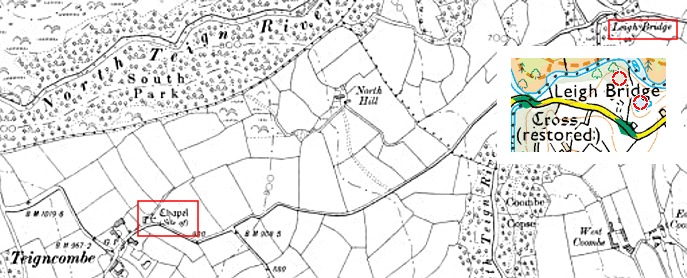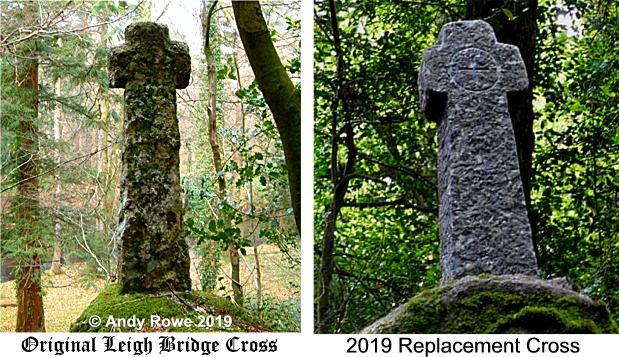
Just to the west of Chagford the North Teign river flows past the famous Gidleigh Park and then takes a sudden dive southwards. After it has recovered from this drastic manoeuvre it then flows under an ancient bridge known as ‘Leigh Bridge’ and today the bridge carries The Two Moors way as it wends from Lynton to Ivybridge. High up on the left-hand side of the road, mounted upon a large boulder stood and ancient cross known as Leigh Bridge Cross.
About 1.5 kilometres to the south-west of the bridge is the small hamlet of Teigncombe where one can find Teigncombe Farm (location of the one-time skunk farm). Although quite a distance apart both the cross and the farm have a possible connection. If you look at the old Ordnance Survey map of 1888 you will see that Teigncombe Farm is marked and Leigh Bridge is marked but there is no mention of the cross. If you then look at the extract from the modern Ordnance Survey map you will see that suddenly just over one hundred years later the cross appears? Clearly one could assume that either the cross was a modern addition or that it had been moved from another location. Either way due to it’s comparatively recent appearance proven by the two OS maps it is hard to imagine that the cross ever stood alongside the old Mariner’s Way whilst it was in use. Therefore although today technically it can be called a wayside cross as it sits beside a road it was never the original wayside cross on the Mariner’s Way.
If you take another look at the old Ordnance Survey map you can see that to the left of what is now Teigncombe farm there was a chapel. Buried deep in the depths of local tradition there is the suggestion that this small medieval manorial chapel was used to rest coffins prior to burial in Chagford church? Today all that remains of the structure are some low walls and evidence of a fireplace which according to the English Heritage Field Investigators is or never was a chapel. However, just past Teigncombe Manor set in the hedgebank and serving as a modern gatepost is what appears to be a circular socket stone along with a rectangular central hole once possibly belonging to a cross.

OK, let’s park the story there for a while and travel forward in time to the 20th century, 1910 to be exact and here we meet Mr. Clampitt. Sadly he had lost his wife and wished to erect a memorial or two in honour of her memory. The first went on Coombe Tor and as popular opinion has it the other was Leigh Bridge Cross. The question is where did Mr. Clampitt get the cross which he erected at Leigh Bridge? Bill Harrison suggested that the head of the cross came from nearby Waye Barton and this along with a new shaft ended up as Leigh Bridge Cross. This idea was based on some remarks made by William Crossing who viewed the old cross head at Waye Barton in 1892. In his book; ‘The Ancient Stone Crosses of Dartmoor‘ he notes that he had found an old cross head with its arms knocked off. Also he discovered evidence of an incised Latin cross about 17 inches long and 8 inches wide, p.136. To justify this conclusion Harrison also notes how there is also an incised cross on Leigh Bridge Cross and additionally he had been told that it was one Mr. Skeeping who had restored it, p.262. Therefore in his opinion this is how the cross became to be located above Leigh Bridge.
Now let’s zoom back down the centuries to the supposed medieval chapel at Teigncombe. If there was indeed a small chapel there would it not be possible that it possessed a granite cross? According to F. H. Starkey he was told by J. S. Somers Cocks, (a Dartmoor cross expert), that the Leigh Bridge cross head surely originated from Teigncombe and that its socket stone is the one now serving as a gatepost as mentioned above. He also confirmed that it was Mr. Clampitt who instigated the restoration as a memorial to his wife.
So there you have two very plausible but differing explanations of how Leigh Bridge cross came to be. What both agree on is that it was dear Mr. Clampitt who was responsible for the cross and its location. Personally I tend to favour the Teigncombe version as there is a very strong local belief in the existence of the chapel despite what English Heritage say. Couple this with the existing socket stone and you have two parts of a cross.
Finally it would be useful to briefly mention what the vital measurements of the cross were. It is 1.22 metres high, has an arm span of 38 centimetres and a circumference of 80 centimetres. There is the feint impression of an incised cross on the side facing the road.
You may have picked up on the fact that I said; “what the vital measurements of the cross were,” as opposed to are. There is a very sad reason for this, in the June of 2013 somebody reported to the Dartmoor National Park Authority that Leigh Bridge cross had vanished. A local Park Ranger went to investigate and found just a short section of the cross shaft protruding up from its boulder. On closer inspection he found the rest of the cross which had tumbled down the bank. It had effectively been decapitated with its head parted from its shaft. It appears that the cause of this catastrophe was the freeze, thaw action of the winter’s frosts and cold weather. Even more disastrous is the fact that in all probability the granite head cannot be restored and even if it could there are no funds to do so anytime soon, Mason, 2015.

Good news – In the July of 2019 the Dartmoor National Park Authority announced that a brand, spanking new cross had been erected on the site of the old cross. Fashioned from granite and engraved with a circle and internal cross the new cross stands proudly on the bank beside the road. It’s refreshing to see that despite funding cut-backs the authority deemed fit to restore the tradition of ancient crosses on Dartmoor.

Crossing, W. 1987. The Ancient Stone Crosses of Dartmoor. Exeter: Devon Books.
Harrison, B. 2001. Dartmoor Stone Crosses. Tiverton: Halsgrove Publishing.
Mason, S. 2015. Leigh Bridge Cross – Dartmoor News, Issue 144. Okehampton: The Dartmoor Company
Sandles, T. 1997. A Pilgrimage to Dartmoor’s Crosses. Liverton: Forest Publishing.
Starkey, F. H. 1989. Dartmoor Crosses and Some Ancient Tracks. Exeter; A. Wheaton & Co.
 Legendary Dartmoor The many aspects past and present of Dartmoor
Legendary Dartmoor The many aspects past and present of Dartmoor
